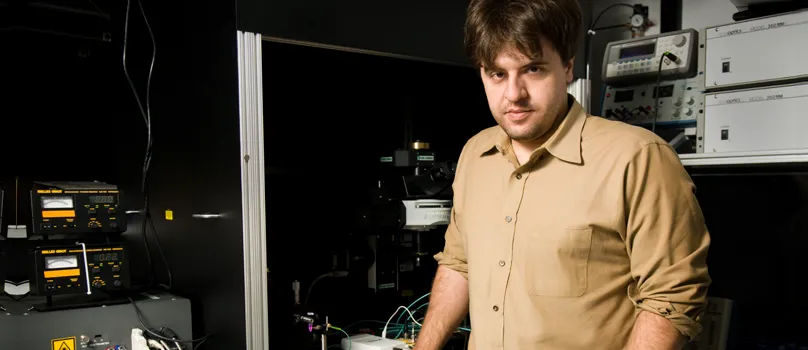
Inside Stanford Medicine - March 18th, 2010 - by David Orenstein
Recently, brain researchers have gained a powerful new way to troubleshoot neural circuits associated with depression, Parkinson’s disease and other conditions in small animals such as rats. They use an optogenetics technology, invented at Stanford University, that precisely turns select brain cells on or off with flashes of light. Although useful, the optogenetics tool set has been limited.
In a paper published in the April 2 edition of Cell, the Stanford researchers describe major advances that will enable a much wider range of experiments in larger animals.
The new capabilities of optogenetics include ways to use any visible color of light to control cells, and ways to make cells susceptible to the optogenetics technique even if they cannot be genetically engineered directly.
The new capabilities include ways to use any visible color of light (instead of just a few) to control cells, and ways to make cells susceptible to the optogenetics technique even if they cannot be genetically engineered directly. To date, optogenetics worked by using a specially engineered virus to insert genes into cells so that they would make light-sensitive proteins. It hasn’t been possible to do that for every cell in every creature scientists want to study with the technique.
“These advances demonstrate a systematic way to add more instruments to the optogenetic orchestra,” said Karl Deisseroth, MD, PhD, associate professor of bioengineering and of psychiatry and behavioral sciences, and senior author of the paper. “Instead of trying to play a symphony with just an oboe and a drum, we now have a well-defined path to collect many more instruments with which we can play the music.”
One of the most important new “instruments” is the ability to use light bordering on infrared wavelengths to suppress cell activity. Those wavelengths penetrate much deeper in living tissue, meaning that cells can be turned off in a larger area of the brain. This is crucial both for producing more widespread and stronger effects in small animals, and for producing meaningful effects in larger animals, such as primates. Light at the infrared border can also deliver less energy to tissue than can the higher wavelengths, which may make it especially safe.
Meanwhile, being able to use any color to control cells also opens the door to performing more complex experiments, because more colors of light could be used at the same time. It would now be possible, for example, for a researcher to use a blue light to activate one kind of cell, and a far-red light to shut off another kind, and study the effect of that combination. In the past, optogenetics was limited to the use of blue and yellow light.
The other key advance is the ability to harness intracellular “trafficking” to spread the optogenetic effect throughout a brain circuit without needing a detailed knowledge of the genetic makeup of every cell involved. Instead, the optogenetic effect can be shared among cells based simply on their connection. Genetically modifying some cells is still necessary, but now it is easier to modify others in a circuit because, with the new method, their mere connection to altered cells via the circuit will modify them as well.
Deisseroth likens cellular trafficking to a postal system, in which cells move proteins and other molecules around internally and between each other. Optogenetics genes are derived from microbial cells, which use a different method of “addressing” than do mammalian cells. By adapting the optogenetics genes to be compatible with the mammalian addressing system, Deisseroth’s team enabled mammalian cells to “traffic” optogenetics genes to the correct location within cells.
The new genes Deisseroth’s team developed, both for employing new colors of light and for spreading via trafficking, are already available to other researchers. “In fact there has been a very high demand already from the community,” he said.
Like optogenetic effects in brain tissue, the means to study neural circuits using optogenetics are spreading through a network of academic and institutional researchers connected by the desire to make new discoveries that benefit human health.
The paper’s other authors are graduate students Viviana Gradinaru, Feng Zhang, Joanna Mattis and Rohit Prakash; laboratory manager Charu Ramakrishnan; and postdoctoral scholars Charu Ramaktrishnan, PhD; Ilka Diester, PhD; Inbal Goshen, PhD; and Kimberly Thompson, PhD.
External funding for the group came from the National Institutes of Health, the National Science Foundation, the California Institute for Regenerative Medicine, the German Academic Exchange Service, the Human Frontier Science Program, the Machiah Foundation, the Weizmann Institute, the National Alliance for Research on Schizophrenia and Depression, and the Woo, Yu, Keck, Snyder, McKnight and Coulter foundations.
The Department of Bioengineering is jointly supported by Stanford’s Schools of Medicine and Engineering. More information about the department, which supported the work, is available at http://bioengineering.stanford.edu.



